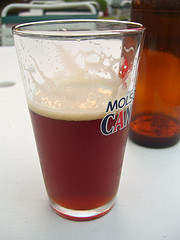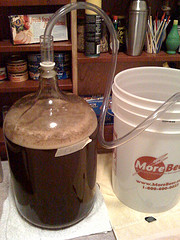Variations on Chocolate Stout
As mentioned in the Brewing Résumé post, I once attempted a clone of Dieu du Ciel’s Aphrodisiaque stout, brewed with cocoa and vanilla. While the result was decent, if not very close to the original, it was popular enough that I am now left with only a single bottle of it. Various people have strongly hinted that they would like some more of this beer, so I was obliged to re-brew it.
After tasting Firestone Walker’s Velvet Merkin and similar beers, I decided to base the recipe on an oatmeal stout rather than a foreign extra stout as before. Oats are high in beta-glucans, provide a nice body and silkiness, and help with head retention. The recipe was based on the oatmeal stout from Brewing Classic Styles, with a couple of modifications. To avoid doing a cereal mash, I used regular flaked oats instead of old-fashioned, rolled ones. I also baked them in the oven until they turned golden and had a nice toasty smell and flavor. The Victory malt was reduced a bit to avoid saturating the beer with its biscuity taste, and I upped the roasted barley a tad and added a bit of Carafa II Special malt — a dehusked version of normal Carafa — to intensify the aroma and color without adding astringency. A portion of East Kent Goldings hops used for bittering was replaced with Willamette and the EKG was moved 30 min to give a bit of hop flavor.
There are various ways to add chocolate flavor to beer, including raw cocoa nibs, cocoa powder, chocolate syrup, or even just chocolate malt. Cocoa nibs are supposed to give a more integrated taste, but they require the beer to be on them for a couple of months, so I just went with what I used last time with good results — cocoa powder added at the last minute of the boil. Some advocate adding cocoa powder to secondary, and I might try that approach in the future. The vanilla flavor will come from organic vanilla beans. (I picked up 2 Indonesian beans at Whole Foods for the low, low price of $11 #sarcasm.)
San Francisco water is really soft, so I added some baking soda to keep the mash pH from falling too much due to the presence of dark malts.
While working on the recipe, I happened upon the Breakfast Stout Riffs post on The Mad Fermentationist blog, which I’ve been reading a lot lately. Mike, the author, brewed an imperial stout and split the batch into different secondary fermenters to experiment with various additional ingredients. I was inspired by his approach, and decided to split my 5-gallon batch as well. The first two variations were easy: 2 gallons would go on top of medium-plus toast American oak cubes soaked in bourbon and some vanilla bean, and 1 gallon would have regular medium toast Hungarian oak cubes and some vanilla as well. After some hard thinking about the third variation, I simply stole the recipe from Mike — a half each of dried ancho and guajillo chile peppers, vanilla bean, and a bit of cinnamon. The final gallon was a complete gamble: sour cherries and dregs from a couple of bottles of Orval (basically adding Brettanomyces and some funky bacteria). I’ve never used fruit or Brett in beer before, so it will be interesting to see how this portion turns out (a few months from now, since Brett works fairly slowly).
I’m going to post a brewing/fermentation log, similar to how The Mad Fermentationist does it, and see if it’s helpful or not. The log will be updated as the beer progresses through fermentation, finishing, and tasting. (Feedback is appreciated.)
Overview
――――――――
Type: All-grain
Batch Size: 5 gal
Total Grain: 13.88 lbs
Expected OG: 1.060
Expected SRM: 41.7
Expected IBU (Rager): 35.7
Brewhouse Efficiency: 70%
Wort boil time: 90 min
Fermentation Temperature: 68°F
Fermentables
————————————
10.0 lbs. Maris Otter 72.1%
1.25 lbs. Flaked Oats 9.0%
0.75 lbs. Chocolate Malt (US) 5.4%
0.63 lbs. Roasted Barley (US) 4.5%
0.50 lbs. Caramel 80L malt (US) 3.6%
0.50 lbs. Victory Malt (US) 3.6%
0.25 lbs. Carafa II Special (Germany) 1.8%
Hops
————
1.3 oz. Willamette [5.0% AA, pellet] @ 60 min.
1.0 oz. East Kent Goldings [5.0% AA, pellet] @ 30 min.
Extras
——————
1.00 Whirlfloc @ 15 min.
1.00 Servomyces yeast nutrient @ 10 min.
6 oz. Cocoa powder (unsweetened) @ 1 min.
Yeast
—————
White Labs WLP002 – English Ale
Water Profile
—————————————
San Francisco tap + 5 g of baking soda to the mash
Mash Schedule
—————————————
Type: single infusion
Saccharification rest: 60 min. @ 154°F
Notes
6/16/10
Brew day, by myself.
Made a 1.5 L starter two days before; good activity.
Decided to add 2 oz of pale chocolate malt and 2 oz of flaked barley for additional body to the grist.
Added 5 grams of baking soda to keep the mash pH from falling too far. Batch sparged in 2 steps. Collected 7.4 gal of wort at 1.055.
Extended pre-hops boil time by 10 min. to allow for more evaporation.
Wort chiller tubing broke after 10 min spraying a tad of water into the wort. Replaced the tubing. Chilled to 70°F, ended up with 5.5 gal of wort. Transferred 5 gal and aerated. Pitched 1 L of the starter after decanting 0.5 L. Fermentation started in about 4 hours.
6/18/10
Active fermentation, temp at 72°F despite using the cooler, so just letting it ferment at room temp.
6/19/10
Really thick yeast cake, this WLP002 yeast is definitely floculant. Gravity down to 1.026.
6/22/10
Gravity down to 1.022. Transferred to secondaries, split 4 ways:
- 1 oz medium-plus toast American oak cubes soaked in bourbon for a week + 1 Indonesian vanilla bean (2 gal)
- 1/2 oz medium toast Hungarian oak cubes + 1/3 Indonesian vanilla bean (1 gal)
- 1/4 tsp cinnamon + 1/2 ancho + 1/2 guajillo + 1/3 Indonesian vanilla bean (1 gal)
- 1/2 lb pitted sour cherries
6/24/10
Pitched a small starter made from the dregs of 2 Orval bottles into the cherries portion.
7/6/10
Bottled everything but the funky portion with 3 oz of dextrose. The final volume turned out to be less than 4 gallons, so hopefully it won’t be over-carbonated.
7/30/10
The bottle I used CarbTabs in didn’t carbonate much. Opened a bottle of the American oak variation, and that one carbonated beautifully. Nice foamy mocha-colored head that recedes to thin persisting ring. Good body, those flaked oats definitely help the fullness and smoothness of the mouthfeel. The chocolate and vanilla are present, but subtle, which is nice. The oak tannins help the mouthfeel as well. Overall, pretty enjoyable.
8/31/10
Received 31 averaged score in MoreBeer Forum Competition (33/33/27 individual scores). Entered into 21A category (Spice/Herb/Veg beer). Criticism was that there was too much cocoa flavor and aroma, covering up vanilla and malt. Also, a bit of astringency.




![Reblog this post [with Zemanta]](http://img.zemanta.com/reblog_c.png?x-id=e9adf3c1-74b8-4f6b-9fb2-441b8845b5fc)